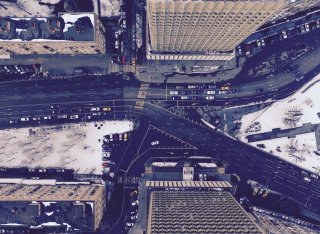FUTURE: Fluid dynamics of urban tall-building clusters for resilient built environments
Start date
June 2021End date
June 2025Overview
The world is witnessing rapid urbanisation, where 70 per cent of its population is expected to live within city environments by 2050 [1]. The main solution to urban development needed to treat the economic and population immigration has been to construct tall buildings, which provides high-density residential and commercial spaces in the hearts of our cities.
However, recent years have witnessed increasing concerns regarding public health and wellbeing in dense urban environments. For instance, it is known that the urban heat island effect, where urban areas are typically some degrees hotter than the surrounding rural areas, can contribute to death rates during heatwaves [2]. To exacerbate these issues, as recognised by the London Plan [3], ‘‘some climate change is inevitable…” and this is likely to increase the frequency and severity of extreme weather events, and the consequent urban health risks.
The current COVID-19 crisis has also highlighted the importance of predicting pathogen dispersion and of efficient indoor/outdoor ventilation in urban areas [4]. It is, therefore, in the public interest to develop strategies that support the construction of healthier and more sustainable urban environments and thereby ensure that air quality, wind, temperature, pollutant concentrations, and the anthropogenic heat do not reach unacceptable levels.
Despite the likely effects of the proliferation of tall structures in exacerbating some of the problems discussed above, current weather and air quality models do not cater for these and their long-lasting effects on the winds and temperature fields within urban neighbourhoods. To overcome these limitations, this project employs a synergy of wind-tunnel tests, field observations, high-fidelity computer-aided analysis, and theoretical models to develop publicly available fast turnaround models that describe the effects of tall buildings on the quantities of interest described above, ultimately to help promote the development of healthier cities.
The work will be carried out by the Universities of Surrey (lead), Reading and Southampton and uses two areas of London as exemplars of high-rise development.
References
- Revision of World Urbanization Prospect (2018). DESA, UN.
- Vardoulakis et al. (2016). Environmental Health 15, S30.
- The London Plan (2017). Greater London Authority.
- ECDC Tech. Report (2020). European Centre for Disease Prevention and Control.
Aims and objectives
Policymakers, regulators and professionals need tools to allow them to design more resilient urban environments.
The objectives of this project are:
- To understand the magnitude and spatial scale of the effects of a cluster of tall buildings, and the consequent impact on wind, scalar, and temperature fields in urban boundary layers
- To identify the main parameters that govern the extent and character of the near and far fields within the wake (e.g. characteristic geometrical properties, heat transfer rates, stability conditions in the upstream boundary layer)
- To assess what can be said generically (i.e. modelled) and what remains site-specific
- To develop fast, analytical models that describe the behaviour of wakes downstream of groups of tall buildings
- To collate this information within a set of guidelines and tools publicly available to professionals, regulators, and policymakers.
These objectives are achieved via a unique combination of experimental, numerical, and mathematical methods in a highly synergistic approach linking fundamental studies, model development, and applications. Following this approach, an open-source online tool and associated set of guidelines comprising advice, rules, and procedures for treating issues associated with tall buildings will be developed to support the industrial (private) and government (public) sectors.
These online tools and guidelines will be presented to all partners during workshops, where training in the use of the latter will also be provided.
Funding amount
~£1.8 million
Funder
Team
Principal investigator

Dr Marco Placidi
Senior Lecturer in Experimental Fluid Mechanics
See profileCo-investigators

Professor Alan Robins
Professor of Environmental Fluid Mechanics
See profile
Dr Matteo Carpentieri
Associate Professor in Environmental Fluid Mechanics
See profile
Dr Paul Hayden
Research Fellow
See profile
Dr David Birch
Associate Professor in Aerospace Engineering
See profileCollaborators
Project led by Surrey, in collaboration with:
- University of Southampton: Dr Zheng-Tong Xie (local PI) and Dr Davide Lasagna
- University of Reading: Professor Janet F. Barlow (local PI), Professor Sue Grimmond and Dr Omduth Coceal.
News
In the media
Outputs
Publications
- Nguyen, C.H., Inam, S., Lasagna, D. et al. Aerodynamics and Wake Flow Characteristics of a Four-Cylinder Cluster. Flow Turbulence Combust 110, 1091–1115 (2023). https://doi.org/10.1007/s10494-023-00419-0
- Coburn, M., Xie, ZT. & Herring, S.J. Numerical Simulations of Boundary-Layer Airflow Over Pitched-Roof Buildings. Boundary-Layer Meteorology 185, 415–442 (2022). https://doi.org/10.1007/s10546-022-00738-1.
- A.L.V. Melo, J.M. Santos, N.C. Reis, I.P. Castro, E. V Goulart, Z.T. Xie. Influence of wind direction and source location on peak-to-mean concentration ratios in urban environments. Journal of Wind Engineering and Industrial Aerodynamics 232, (2023), 105264.
- Melo A, Santos J, Reis N, Castro I, V Goulart E, Xie Z. Influence of wind direction and source location on peak-to-mean concentration ratios in urban environments. Journal of Wind Engineering and Industrial Aerodynamics, 232, 105264 (2023).
https://doi.org/10.1016/j.jweia.2022.1052. - Chen, Y.; Djidjeli, K.; Xie, Z.-T. Freestream Turbulence Effects on the Aerodynamics of an Oscillating Square Cylinder at the Resonant Frequency. Fluids (2022), 7, 329. https://doi.org/10.3390/fluids7100329.
- Measuring and mitigating city microclimates , Building Engineer, Chartered Association of Building Engineers (2022).
- Abhishek Mishra, Marco Placidi, Matteo Carpentieri, Alan Robins. Wake Characterization of Building Clusters Immersed in Deep Boundary Layers, Boundary-Layer Meteorology 189, 163–187 (2023). https://doi.org/10.1007/s10546-023-00830-0.

